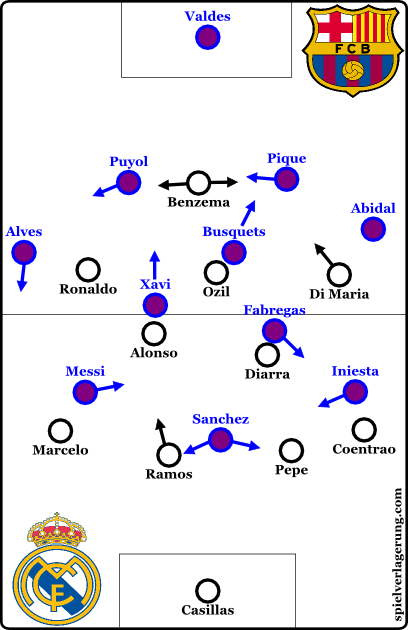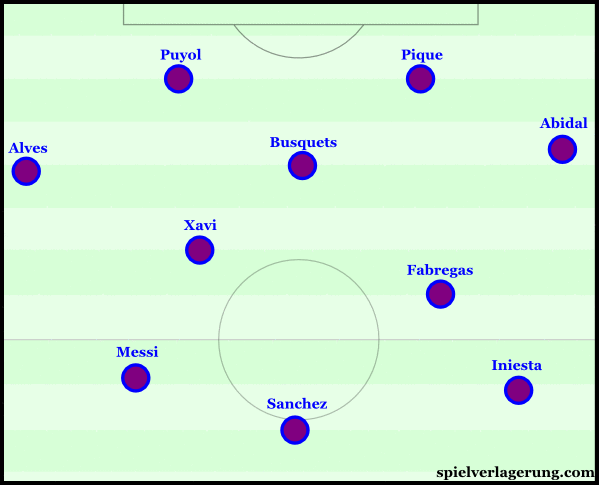Guardiola’s men wrestle control with structural shift
Jose Mourinho’s Real Madrid met Guardiola’s Barcelona at the Bernabeu on the evening of the 10th of December 2011. Mourinho’s men went into the game with a 3 point advantage and were desperate to add to their solitary victory over their arch-rivals in Mourinho’s tenure.
Madrid’s pressing scheme
It’s often said that teams press “right from the off” and in this case that is no exaggeration, within 22 seconds Madrid had pressed, won the ball from a Valdes mistake and scored the opener. Whilst their pressing did not quite yield the same results for the rest of the game it was quite effective at disrupting Barcelona’s rhythm.
While most teams often start their pressing attempts with high central occupation as they aim to force opponents out wide to regain the ball, Madrid’s scheme was slightly different. Madrid aimed to force Barcelona into an unstable possession game and force them into a transition game, the nightmare of one Pep Guardiola. Therefore Di Maria and Ronaldo occupied positions between the centre backs and full-back on their side to prevent Barcelona using their full-backs to escape Real’s pressing and intensity in the centre.
With Ozil situationally marking Sergio Busquets, Benzema was often in the front line on his own and only attempted to press once one of Barcelona’s centre backs received the ball. Once they had received it Benzema would press from between them in an attempt to prevent switches between the two and force them into quick vertical progressions.
On the occasions that Barcelona managed to switch between their central defenders Di Maria would sprint diagonally forwards to press the receiver and attempt to force Barcelona back into the high pressure centre. With the forwards doing a good job of directing Barcelona’s build-up the midfield 3 were given a clear orientation as it became far easier for them to know where to position themselves.
In midfield Madrid were man-oriented and aggressive, particularly on the ball-near side. They pressed intensely and built high resistance to any progressions from Barcelona. By remaining man-oriented and thus goal side of their opponents they pressed with the aim of preventing Barcelona from turning out. This was not limited to the midfield, with Barcelona’s moderate presence on the last line Ramos was often free to break away from the defensive line and dynamically close the space between the lines of defence and midfield.
This was highly effective in the opening exchanges, Barcelona were not only a goal down but found it difficult to dominate the rhythm of proceedings and were forced into several turnovers in midfield, the likes of which would have had Pep scratching his (not yet bald) head. Whilst Barcelona struggled with their lack of stability in the game, Madrid thrived on the relative chaos and transitional nature of the early exchanges but a shift is never too far with Pep around….
Barca’s changing positional dynamics
Barcelona began in a rather orthodox 4-3-3 shape as the line-up hinted they would. In their deep build-up situations they attempted to use Valdes as a back passing option to escape the cover shadows of Benzema and switch between the centre backs. However Di Maria’s diagonal pressing efforts meant the new receiver was under pressure and forced into a similar situation as the centre back immediately before. One major cause of their early issues was the height of the full-backs in build-up. With the full-backs remaining rather deep in build-up Ronaldo and Di Maria in particular could easily retain access to the near side centre back whilst covering the full-backs.
Real Madrid’s pressing structures were well prepared for Barcelona in this shape, thus Guardiola adapted the structure to gain the stability they so craved. Barcelona shifted into a back 3 with only one major movement namely; Alves moving higher and acting as a right winger. There were also a number of changes in midfield, Busquets was now acting between a left centre back and left holding midfielder whilst Xavi dropped to a position almost alongside him when in midfield. Messi then came infield to act as a right #10 opposite Fabregas as Barcelona shifted into something of a 3-2-4-1.
This shift caused some confusion in Real’s pressing dynamics and allowed Barcelona to get a foothold in the game. Firstly the use of 3 centre backs meant Benzema lost his initial reference point. Whilst he could press from a position between 2 of the centre backs he could not cut the connection between all three of them. This meant he would need the assistance of the wide players in pressing efforts. Whilst Di Maria was often free to assist due to Abidal’s low base position, the advanced positioning of Alves dragged Ronaldo back and prevented him from joining the front line.
Furthermore on the occasions Busquets moved higher he took Ozil deeper with him and this combined with Xavi’s dropping movements gave Barcelona a fairly easy route into midfield. With Madrid’s ability to press being far stronger on their right than their left side, Barcelona began to increasingly target Madrid’s left side. With Xavi (often free to receive from the defence), Messi, Alves, at times Busquets and Sanchez they progressed with heavy overloads on the right.
When they were not able to break through with combinations on the near side there was acres of space for Iniesta to receive passes on the left flank and with these switches they could force their opponents to retreat. Whilst these changes gave them some control over proceedings the player roles were not quite perfect and they struggled to beat break Real’s defensive line.
Barca’s offensive player roles
From his position out on the left flank Iniesta was often located with long switches that isolated him against Coentrao. However his dribbling style and press resistance would have been of better assistance in central areas to help Barcelona break through the high pressure centre. On the flank he often had to wait for the likes of Sanchez or Fabregas to shift over to the wing to combine wit them and move into the left half space.
Sanchez’s initial role was as something of a free runner roaming along the front line and balancing Messi’s movements to balance the structure and create through ball possibilities. Whilst this meant he was free to support Iniesta on the left, it often took too long and the dynamic on the left flank was not optimal.
Quickly realising this Pep adapted once again and Sanchez moved out to a starting position on the left flank not long before the half hour mark. Not long after Barcelona scored their equaliser which was a direct result of their adaptations. Moving Alves to the right flank gave Messi the freedom to drop into areas within the midfield that Ramos would not follow him into. It was this free roaming that allowed Messi to receive the ball from Pique and his press resistance was vital in evading several changes and advancing with the ball. Sanchez’s diagonal run from the left flank created the possibility for the through ball. This proved Sanchez could provide depth as well as using his skill set in isolation situations from his left wing position.
2nd half
Barcelona’s defensive ball circulation
In the 2nd half much of Barcelona’s controlled possession came from transition situations. When Real Madrid’s attacks broke down, Barcelona would often carry the ball into the opposing half before settling to control proceedings from there. Their offensive intentions were secondary to the control they sought through retaining possession in Real’s half.
However to reach Real’s half in these transition situations and to maintain possession once they were there Barcelona had to demonstrate great press resistance. They achieved this in two main ways, individual and collective press resistance. At times when the ball was in isolated areas Barcelona had to rely on the dribbling ability of the likes of Iniesta, Xavi and Messi to retain the ball against Real’s pressing. However in several other situations they moved collectively and combined through their strong triangle and diamond like structures to retain the ball collectively.
Their ball circulation had a heavy central focus which also had the benefit of creating stability upon turnovers. With the centre heavily crowded the home side would have to play to the flanks to find space to launch counter attacks. From these positions the strong anticipation from the likes of Abidal and Puyol combined with Busquets filling positions in the back line allowed Barcelona to either weaken or stop Madrid’s counters. It was this central positioning that meant Xavi was in position to fire Guardiola’s men into the lead from the edge of the box.
Madrid’s direct game
As the half wore on Madrid were increasingly direct which had some benefits but more negatives. They often looked to exercise their aerial advantage with direct balls into Barcelona’s half. This helped them avoid Barcelona’s pressing and start attacks from more advanced positions when it worked. However it often made them unstable and vulnerable to Barcelona’s counter attacks.
However they did manage to create a couple of dangerous situations, particularly with Benzema moving to the left flank and the interactions he had with the more centrally positioned Marcelo.
Conclusion
Barcelona came back to win a crucial game in their rivals’ backyard despite going behind within 22 seconds. This was in no small part to their outstanding individual qualities and Pep’s ability to give them a platform to emphasise these talents. Despite such a crucial loss Mourinho’s men would go on to win the league with a record points total leaving Barcelona 9 points adrift. A Champions League semi final exit to Chelsea meant that Guardiola’s last year at Barcelona would end with a solitary Copa Del Rey triumph.




Keine Kommentare vorhanden Alle anzeigen